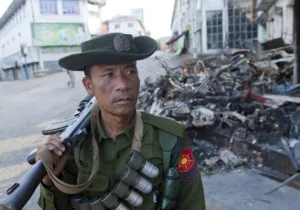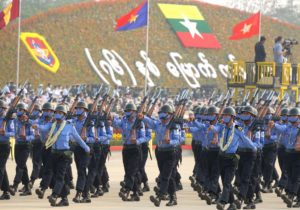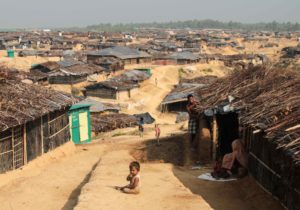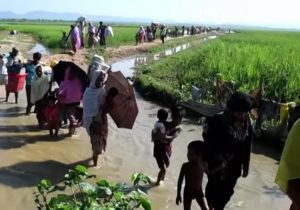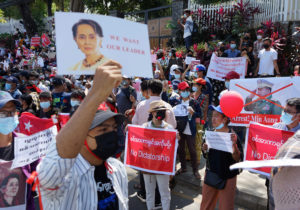The Karenni ethnic minority boasts the largest concentration of Catholics in Burma. Catholic soldiers persist in the decades-long struggle against the Tatmadaw (Burmese junta forces), while nuns, priests, and believers hold on to their faith despite war and destruction.
Though Myanmar is a diverse nation with 135 ethnic groups, Myanmar’s military government is mainly made up of individuals from the Burman ethnic group. Unsurprisingly, the many ethnic groups unrepresented in the Burmese government have faced repression under the military junta’s rule. The conflict traces back to 1948 when ethnic armies first took up arms against the military. Shockingly, this conflict is still ongoing today, making Myanmar the site of the world’s oldest continuous conflict.
Buddhism stands as the predominant religion in Myanmar, while the Catholic minority has a history in the country dating back over 500 years. Since Myanmar gained independence in 1948, successive military regimes have portrayed Catholics as traitors, subjecting them to repression.
Until General Ne Win’s 1962 coup, the education provided by the Catholic Church played a crucial role in Myanmar’s development. Sai Leng, a seventy-two-year-old headman of a refugee camp, spoke excellent English, a skill he acquired at a convent school in Tungyi, the capital of Shan State, during his childhood. “The priests were Italian, but they taught in English,” he mentioned.
A member of the largely Buddhist Shan ethnic group, Sai Leng explained that although students at the Catholic school had to attend chapel and religious instruction, there was no requirement to convert to Catholicism. In his case, he remained a Buddhist but fondly remembered the nuns and priests who taught him and regretted the day they had to flee. Though Sai Lang is fluent in English, the destruction of religious education in Burma has significantly reduced the number of English speakers in the country.
Ne Win retired from his position as dictator in 1988. Eventually, the military junta took control, and General Saw Maung became the leader of the State Law and Order Restoration Council (SLORC) from 1988 to 1992. After Saw Maung, General Than Shwe assumed leadership and ruled until approximately 2011, when the country transitioned to a nominally civilian-military fusion government.
In 2015, Aung San Suu Kyi’s National League for Democracy (NLD) won a decisive victory in the general elections, ushering in a period of relative peace and nominal democracy for four years. During this time, Myanmar welcomed a historic visit from His Holiness, the Pope, in 2017. This visit held significant meaning, especially for Catholics who had endured persecution for generations.
However, the democratic progress was short-lived. Following Aung San Suu Kyi’s reelection, a military coup unfolded in 2021, resulting in the imprisonment of the Nobel Laureate, as well as many of her supporters. This served as the catalyst that ignited the nation against the military government, marking the first time since 1948 that the entire country, including the Burman majority, united in opposition to the junta. Myanmar has been in the midst of civil war ever since.
Today, it is estimated that there are between 500,000 and 750,000 Catholics in Myanmar, with a high concentration among the Karenni ethnic group who live in Kayah State (also known as Karenni State), the smallest of Myanmar’s seven ethnic states.
Khu Ko Reh, a thirty-seven-year-old, serves as the director of the Karenni Civil Society Network, a group that advocates for aid to Karenni refugees in Thailand and those still in Kayah State, facing the challenges of the ongoing war. He shared with me, “Most of our soldiers are Baptized Catholics.” The priests and nuns play a crucial role, offering lessons, comfort, and leadership to internally displaced people (IDP) as well as to the wounded, both civilians and military personnel.
Highlighting the increased brutality of the regime since the coup, Khu Ko Reh stated:
“In the past, they (the Burmese army, the Tatmadaw) mostly dropped bombs where fighting was taking place. It used to be that when the bombs were falling, civilians could seek refuge in buildings. But now, they also drop bombs on IDP camps, clinics, hospitals, schools, churches, and temples.” He continued, “They target public areas and those assisting the refugees.”
David Eubanks, the founder of the faith-based aid organization Free Burma Rangers, reported that he personally witnessed the Tatmadaw using a Russian helicopter to attack a Catholic church. He said, “They fired missiles at it, and there was no logical reason why.” Both refugees and soldiers have been affirming that the Tatmadaw is deliberately targeting churches and cathedrals. Khu Ko Reh mentioned that frequently, the Tatmadaw will bomb a church to force everyone out, following which they take it over and use it as a base for their soldiers.
Before the 2021 coup d’état, many Burmese and a significant portion of the international community deemed the ethnic armed resistance groups as terrorist organizations. However, since 2021, there has been a notable shift both inside and outside the country. Burmese citizens are now turning to the jungles, seeking assistance from ethnic resistance groups for weapons and combat training. The collaboration among ethnic armies, rather than internal conflicts, and the backing of People’s Defense Forces (PDF), which include ethnic Burmans, are collectively turning the tide of the war against the Tatmadaw.
This unity is precisely what the Tatmadaw has always feared. Khu Ko Reh recalled, “In the past, the Myanmar forces wanted to portray the ethnics as terrorists. So, they conducted false flag operations, attacking other ethnic groups or religions and blaming it on us, to create divisions between us, to make us hate one another, so we cannot unite against the government.” He smiled and added, “But luckily, we did not fall into their trap.” It is clear that all of the peoples of Burma now know that the enemy is the Tatmadaw.
Despite the challenges, Karenni refugees persist in worship at St. Mary Catholic Church in Karenni Refugee Camp 1 in Mae Hong Son, Thailand. Reflecting on the courage of the nuns and priests ministering to their flock who remained in Karenni state, Khu Ko Reh remarked, “They are very brave.” The civilians and soldiers who persevere in their fight and faith serve as an example for Catholics everywhere.
